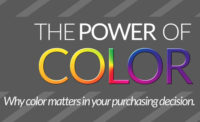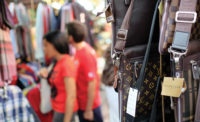Countering the Counterfeiters: How Brands Can Protect Themselves
Countering the Counterfeiters: How Brands Can Protect Themselves
by William Makely
You don’t have to make it impossible to steal your brand identity—just make it extremely complex and costly to try.
Your brand is valuable. In fact, the reason for branding is to signal special value in products—value that cannot be weighed or measured, but that carries an assurance of quality, integrity…all of the traits you have worked hard to make the brand represent. Today though, the odds are that someone, somewhere, is trying to counterfeit your brand. And that puts you at risk.
Duped by these “sharks”, consumers may lose trust in your brand if they feel you are promising quality that you are not delivering. Your choice as a brand owner is to either make it impossible for counterfeiters to operate or make it very difficult for them to even try.
But, you can forget about the first option. Making it impossible for someone to copy your branded package simply isn’t going to happen—especially when anti-counterfeiting specialists suggest that as many as 10 percent of the attendees at brand security conferences may be counterfeiters. That doesn’t mean you can’t foil counterfeiters—you just have to make it very difficult and cost-prohibitive for them to mimic your identity. To do so, you can choose from a variety of protective on-pack technologies, from traditional “overt” markings like bar codes and date/lot codes to the more recently introduced electronic, biological and chemical “covert” identifiers that can be detected only with special equipment.
Special feature containers
One technique for protecting beverages from counterfeiting is the use of a proprietary shape. CCL Container makes such a can for liquid dietary supplements sold by TrimSpa Inc., with the objective of making the distinctively shaped packaging too expensive to duplicate.
“There probably aren’t 10 companies in the world that could make this impact-extruded shaped can,” says CCL vice president of sales and marketing Ed Martin.
“There probably aren’t 10 companies in the world that could make this impact-extruded shaped can,” says CCL vice president of sales and marketing Ed Martin.
Adding to the expense, the shapely cans carry complex lithographed images, including photos, and, soon, will feature a debossed TrimSpa logo on their side.
Soft drink companies have used specialized cans with color-shifting inks or debossed logos, but only on a limited basis for special visual or tactile effect. Clearly, this expensive technique is only suitable for a company with large production runs that will allow it to amortize the cost of the packaging setup by a high-end can manufacturer.
Soft drink companies have used specialized cans with color-shifting inks or debossed logos, but only on a limited basis for special visual or tactile effect. Clearly, this expensive technique is only suitable for a company with large production runs that will allow it to amortize the cost of the packaging setup by a high-end can manufacturer.
Taggants
One of the most effective brand protection systems is that offered by chemical and organic taggants—tiny identification tags that can be added to packaging elements—from inks and labels to papers and flexible pouches—or to products themselves. The taggants are so small they cannot be detected even by advanced computer, chemical or mass spectroscopy analysis. Yet they are immediately detectable by field-testing.
Taggants are usually proprietary to the company making them, as are the detection devices, most of which are hand-held field devices that yield a “yes/no” indication of authenticity.
Taggants offer another benefit: they typically reside in a different location on each individual package or product. Thus, attempts by counterfeiters looking to defeat them by removing the part of the product or package where they have been inserted are often fruitless.
Taggants are usually proprietary to the company making them, as are the detection devices, most of which are hand-held field devices that yield a “yes/no” indication of authenticity.
Taggants offer another benefit: they typically reside in a different location on each individual package or product. Thus, attempts by counterfeiters looking to defeat them by removing the part of the product or package where they have been inserted are often fruitless.
Specialty inks
Inks have developed rapidly in the past few years. Thermochromic and color-shifting technologies have made inks reactive, enabling them to indicate temperature changes in a package, or to let consumers or inspectors instantly see color shifts as overt evidence of authenticity. But the newest inks add hi-tech covert elements that guard against counterfeiting even more effectively.
Sun Chemical is a leader in this new technology, often referred to as “track and trace”. Its SunGuard product invisibly marks packaging using chemical taggants that reside in the ink, to be read only by a proprietary wand or camera. The system is costly, but with SunGuard, the packager has the advantage of using existing graphic and design elements on a package, simply printing them with the tagged inks.
Because the taggants are in the ink, printing can also be done by conventional means, including inkjet printing, in brand owner facilities, right on the filling lines. The idea is to enhance the control brands maintain and to make the invisible ink more integral to the packaging, adding another layer of security.
Sun Chemical is a leader in this new technology, often referred to as “track and trace”. Its SunGuard product invisibly marks packaging using chemical taggants that reside in the ink, to be read only by a proprietary wand or camera. The system is costly, but with SunGuard, the packager has the advantage of using existing graphic and design elements on a package, simply printing them with the tagged inks.
Because the taggants are in the ink, printing can also be done by conventional means, including inkjet printing, in brand owner facilities, right on the filling lines. The idea is to enhance the control brands maintain and to make the invisible ink more integral to the packaging, adding another layer of security.
Laser coding and marking
After the process of coding with ink became widespread, the idea of using a high-performance laser to burn unique codes on packaging substrates followed. The advantage is in the fact that the process doesn’t require extra materials like ink or labels, making the technology easy to integrate into existing production processes. Removing a laser mark is not impossible, but it is very labor intensive and difficult to achieve without marring the surface of a package.
And while laser coders were originally expensive, they have since become more accessible.
They are also ideal for countering product diversion—a practice where authentic products are sold through unauthorized channels—a tactic almost as damaging to a brand as counterfeiting.
And while laser coders were originally expensive, they have since become more accessible.
They are also ideal for countering product diversion—a practice where authentic products are sold through unauthorized channels—a tactic almost as damaging to a brand as counterfeiting.
Holography
Consumer packaged goods companies have begun using holography on tamper-evident bands because such bands have, in the past, been fairly simple to fake. The addition of holography simply makes them more costly to imitate.
Holograms are also frequently found on sports paraphernalia, clothing and other high-end items that are likely targets for forgers. According to Eric Bartholomay of Toray USA, off-the-shelf holograms were often the choice for brand owners in the past. Though, he says, Toray, which makes the films used in hologram applications, has seen that change in recent years.
As counterfeiters became more adept at faking holograms, he says, sporting good manufacturers have switched to custom holograms designed to complement their products as well as protect them.
Brands like Nike have also learned to change the design periodically to make the system even more difficult to replicate. Nike’s MoJo golf balls, for instance, have gone through at least three iterations of their custom hologram in about 18 months. The message to “brand pirates” is that they will have to make a significant investment in custom holography to try and counterfeit MoJo golf balls.
One drawback sometimes cited for holography as a primary anti-counterfeiting measure is that, although consumers can see that a hologram is present, they have no way of knowing that it is authentic. The value of a hologram as a deterrent, though, is that it is expensive for the counterfeiter to create. And, depending on the price point of the product, that may be enough; though most experts advise layering holograms with covert anti-counterfeiting efforts.
Holograms are also frequently found on sports paraphernalia, clothing and other high-end items that are likely targets for forgers. According to Eric Bartholomay of Toray USA, off-the-shelf holograms were often the choice for brand owners in the past. Though, he says, Toray, which makes the films used in hologram applications, has seen that change in recent years.
As counterfeiters became more adept at faking holograms, he says, sporting good manufacturers have switched to custom holograms designed to complement their products as well as protect them.
Brands like Nike have also learned to change the design periodically to make the system even more difficult to replicate. Nike’s MoJo golf balls, for instance, have gone through at least three iterations of their custom hologram in about 18 months. The message to “brand pirates” is that they will have to make a significant investment in custom holography to try and counterfeit MoJo golf balls.
One drawback sometimes cited for holography as a primary anti-counterfeiting measure is that, although consumers can see that a hologram is present, they have no way of knowing that it is authentic. The value of a hologram as a deterrent, though, is that it is expensive for the counterfeiter to create. And, depending on the price point of the product, that may be enough; though most experts advise layering holograms with covert anti-counterfeiting efforts.
RFID… plus
RFID coding does not, by itself, protect against piracy, though major pharmaceutical companies like Pfizer use it for that purpose. Sure, RFID tags can be monitored throughout the distribution and retail chain to locate products, but the presence of an RFID tag doesn’t necessarily guarantee product authenticity for consumers; counterfeiters have proved adept at copying RFID tag numbering schemes to create fake tags.
A new class of flexo-printed inks, however, by such companies as the Canada-based XINK Laboratories, has integrated taggants made by Creo to the ink on RFID antennaes. Such tags can easily be verified as authentic using a simple pen-sized reader. According to the company, the technology elevates XINK-printed RFID tags into the same league of security as currency.
Another new technology comes from Aveso Inc., a spin-off of Dow Chemical. The company has developed labels that carry covert electronic billboards that can be activated by a radio frequency source or through touch, making the hidden billboard apparent so consumers and brand owners can verify the authenticity of the package.
A new class of flexo-printed inks, however, by such companies as the Canada-based XINK Laboratories, has integrated taggants made by Creo to the ink on RFID antennaes. Such tags can easily be verified as authentic using a simple pen-sized reader. According to the company, the technology elevates XINK-printed RFID tags into the same league of security as currency.
Another new technology comes from Aveso Inc., a spin-off of Dow Chemical. The company has developed labels that carry covert electronic billboards that can be activated by a radio frequency source or through touch, making the hidden billboard apparent so consumers and brand owners can verify the authenticity of the package.
Changing practices
Given all these options, it hardly seems possible for counterfeiters to succeed. But think of the goldmine waiting for them if they do, producing what they purport to be branded products at a fraction of the cost, namely because they don’t have to account for the research and development costs, product and package design costs, or market research costs that you do.
To best keep counterfeiters at bay, experts advise using an array of methods.
“You have to use multiple protective techniques, and you have to keep changing them,” says Stan Hart of S. G. Hart & Associates LLC, a leading brand protection consulting firm.
You should also change some of the seemingly innocent practices in your workflow, he says. When you plan a new package, for example, take care not to send multiple samples of your inks, board, graphics, etc., to multiple vendors. Keep those elements close to your vest.
And don’t forget about your customers. They are your product’s lifeblood, so you must consider how to assure them that the package in their hands is genuine.
The most stringent anti-counterfeiting efforts, with multiple covert layers of protection, are mostly directed toward the counterfeiter. What measures do you take to help consumer decide whether a package is authentic?
In the end, those “old-fashioned” devices—logos, graphics, value statements, slogans—all of the symbols that your brand has accrued over the years—still have enormous value to you and to your customers.
It’s what defines the brand that you are taking such extensive, expensive measures to protect. Because it is ultimately the assurance you offer consumers. BP
To best keep counterfeiters at bay, experts advise using an array of methods.
“You have to use multiple protective techniques, and you have to keep changing them,” says Stan Hart of S. G. Hart & Associates LLC, a leading brand protection consulting firm.
You should also change some of the seemingly innocent practices in your workflow, he says. When you plan a new package, for example, take care not to send multiple samples of your inks, board, graphics, etc., to multiple vendors. Keep those elements close to your vest.
And don’t forget about your customers. They are your product’s lifeblood, so you must consider how to assure them that the package in their hands is genuine.
The most stringent anti-counterfeiting efforts, with multiple covert layers of protection, are mostly directed toward the counterfeiter. What measures do you take to help consumer decide whether a package is authentic?
In the end, those “old-fashioned” devices—logos, graphics, value statements, slogans—all of the symbols that your brand has accrued over the years—still have enormous value to you and to your customers.
It’s what defines the brand that you are taking such extensive, expensive measures to protect. Because it is ultimately the assurance you offer consumers. BP
The author, William Makely, is a freelance writer specializing in packaging and technical subjects. Contact him at 630.960.0821 or at billmakely@aol.com.
Where to go for more information...
Laser marking. At Videojet Technologies, contact Theresa DiCanio at 630.860.7300 x1334 or theresa.dicanio@videojet.com.
Anti-counterfeiting consulting. At Pira International, contact Caroline Potapa at +44.0.1372.802101 or CarolineP@pira.co.uk.
Printed RFID antennas. At XINK Laboratories Ltd., contact James Neilson at 613.745.8400.
Shaped containers. At CCL Container, contact Ed Martin at 203.354.4523 or emartin@cclcontainer.com.
Security taggants. At Authentix, contact Phil Martin at 469.737.4400 or phil.martin@authentix.com.
Security taggants. At Creo, contact Kevin Harrell at 604.451.2700 x2187 or traceless@creo.com.
Electronic displays. At Aveso Inc., contact Emily de Rotstein at 763.571.2622 x208 or emily@.avesodisplays.com.
Specialty inks. At Sun Chemical, contact Christopher Morrissey at 708.236.3533 or Chris.morrissey@na.sunchem.com.
Holographic film. At Toray Plastics (America) Inc., contact Eric Bartholomay at 401.294.4511 or eric.bartholomay@toraytpa.com.
Brand protection consulting. At S. G. Hart & Associates, contact Stan Hart at 203.438.4300.
Holography. At ITW Holographics, contact Kevin O’Leary at 978.225.8250 or kevin.oleary@itwholographics.com.
Don’t Give Up the Obvious
The most effective deterrent technology involves covert marking, tagging, etc. But overt (read “visible” or “obvious”) codes and markings on packaging are valuable because they are reassuring to consumers. They are immediately accessible and they suggest authenticity. So regardless of the covert technologies you use to safeguard your brand from counterfeiting, don’t let go of the simple visible codes that reassure consumers that you are watching out for them. They speak directly to your customers, offering them something as valuable as brand recognition—something that no covert protection can do.
Weigh Carefully the Cost of Protection
Counterfeiting is costing companies billions of dollars each year. Pira International estimated it at 10 percent of world commerce. One national newspaper called counterfeiting the “crime of the century.”
What does it really cost your brand? No one can give you a specific figure—which is alarming in and of itself (Though, some anti-counterfeiting suppliers are tossing around the idea of a bonus contract, paid out if they are able to recoup revenue for a brand by identifying a counterfeiting cluster).
But consider how many sales you might have lost because of the deterioration of your brand value in the marketplace, as lower quality “fakes” usurp your product. How far has word-of-mouth damaged your brand when disappointed consumers “chat up” their experience with products posing as your own?
Bottom line: don’t underestimate the value of investing in protection for your brand.
A RESOURCE FOR BRAND OWNERS
This year, seven companies that serve the package printing and converting industry came together to form the Brand Protection Alliance Inc. (BPA). The alliance was established as a resource for brand owners in the design, development and implementation of customized, secure solutions against consumer product counterfeiting and diversion.
Member companies are: Acucote Inc., Atlantic Paper Co., Creo, Dunmore Corp., Kurz Transfer Products and Water Ink Technologies.
Brand Protection Alliance. Contact Brad Long, Kurz Transfer Products, at 704.927.3807.
Looking for a reprint of this article?
From high-res PDFs to custom plaques, order your copy today!








